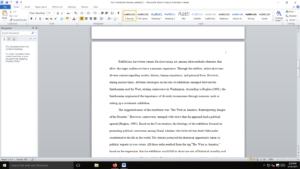The goal of this assignment is to respond to a piece related to something we have encountered so far in class through a close reading of that piece. Each student must write one essay. The paper should be written for an academic audience, with proper citations and style, and turned in through Canvas. Papers should be NO LONGER THAN 6 PAGES (no minimum length). Each paper should include the following:
Part I
- A description of the historical CONTEXT of the piece chosen (when and by whom it was made, what was going in the place and time, etc.
- A brief analysis of the work according to its TEXT (according to genre: paintings should be analyzed in terms of style and theme, brushstrokes, etc.; architecture in terms of building style, layout, etc.; music in terms of lyrics and sound).
- A brief analysis of its SUBTEXT (so you must state what you think the goal or meaning of the piece, what its meaning might be, what this piece might tell us about the culture that created it, and etc., making sure to cite various aspects of the piece (a particular part of the painting or some piece of the story, etc) which supports your interpretation. THIS SHOULD COMBINE YOUR ANALYSIS OF THE TEXT AND CONTEXT.
- Your own personal response to the work. This first part of the response should take a stand with regard to the work. Do you like it? Is it effective? Why or why not?
Part II
The second part of the response should compare the work to another. This other work can be from any period or place other than the previously chosen piece. Briefly (in a page or so) examine your chosen artwork according to the previous 4 steps (Part I). Then, draw a comparison between the two works. The comparison should demonstrate how a similar theme, style, or argument occurred in a different time and place, and how that makes it different from the previously chosen piece.
Requirements: No more than 6 pages.
Some of the topics we covered in class were epic poetry, Chinese landscape paintings you don’t have to use these I don’t think you have to use these but its somethings we went over
Answer preview
In addition, the use of lighter and brighter colors is evident in the painting, contrasting this piece of art with other works by Velázquez. The color technique evident in the painting is a product of Velázquez’s visit to Italy where he learnt Renaissance art as applied in the piece of art. Velázquez uses pastel blue colors and places brown colors on the background and the soldiers. Similarly, Velázquez uses muted earth tones to achieve a realistic character in the paintings. The soldier and the sweeping flags on the right are painted in pastel colors, and it is also clear that bright red colors are not used to signify bloodshed. Another color technique applied is the depiction of space, perspective, and light, where Velázquez aims to transform the viewer into an eyewitness of the encounter presented in the foreground (Berzal De Dios, 2015). The effective use of perception and aerial view in expressing the scene’s size also enhances the viewers’
[2037 Words]


